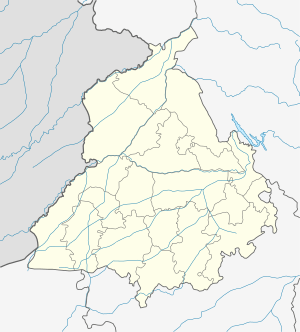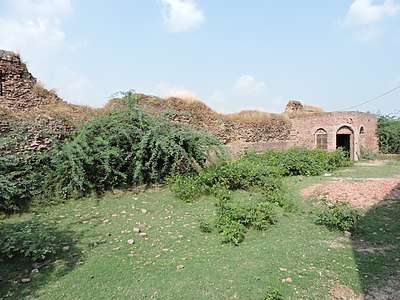Ghuram
Ghuram is a village in the Patiala district of Punjab, India.
Ghuram(ਘੁੜਾਮ) Kuhram | |
|---|---|
Village | |
 Ghuram(ਘੁੜਾਮ)  Ghuram(ਘੁੜਾਮ) | |
| Coordinates: 30.1215°N 76.4768°E | |
| Country | India |
| State | Punjab |
| District | Patiala |
| Tehsil | Patiala |
| Area | |
| • Total | 7.97 km2 (3.08 sq mi) |
| Population (2011)[1] | |
| • Total | 3,165 |
| • Density | 400/km2 (1,000/sq mi) |
| Time zone | UTC+5:30 (IST) |
History
An ancient site called Ram Garh is located in Ghuram. Some coins discovered here were attributed to the ancient Audumbara tribe by archaeologists G. B. Sharma and Manmohan Kumar,[2] but later scholars have assigned these to the Mitra rulers including Indramitra.[3] In 1976, Sharma discovered a seal bearing the Gupta Brahmi legend "Ghvankrum", which may be the ancient name of Ghuram.[4] According to a local tradition, Kaushalya, the mother of the legendary hero Rama, was born in Ghuram.[5]
 Mound of Ghuram
Mound of Ghuram Bhikham Shah Da Maqbra
Bhikham Shah Da Maqbra
Ghuram is mentioned as "Kuhram" in Persian language sources such as Ain-i-Akbari.[2] After the Ghurid ruler Mu'izz ad-Din defeated the Chahamana king Prithviraja III at the Second Battle of Tarain in 1192, he placed his general Qutb al-Din Aibak at Ghuram.[6]
According to a legend, when the Sikh leader Guru Gobind Singh was born at Patna, Bhikhan Shah - a Muslim Sufi fakir of Ghuram - had visions of his divinity. Bhikhan Shah traveled to Patna with some of his followers, and told the Gobind Singh's maternal uncle Kirpal Singh about his visions.[7]
Demographics
According to the 2011 census of India, the village has 3,165 people living in 614 households. This includes 1,670 males and 1,495 females. 519 villagers belong to the scheduled castes. The number of literates is 1,827.[1]
References
- "Patial District Census Handbook" (PDF). Directorate of Census Operations. Retrieved 2019-05-25.
- G. B. Sharma; Manmohan Kumar (1980). "Excavation at Ghuram". Proceedings of the Punjab History Conference. 13. Department of Punjab Historical Studies, Punjabi University. pp. 32–47.
- Devendra Handa (2007). Tribal Coins of Ancient India. Aryan Books International. pp. 236–241. ISBN 978-81-7305-317-7.
- Parmanand Gupta (1989). Geography from Ancient Indian Coins & Seals. Concept Publishing Company. p. 200. ISBN 978-81-7022-248-4.
- Sukhdev Singh Chib (1977). Punjab. Light & Life. p. 2.
- K. A. Nizami (1992). "The Early Turkish Sultans of Delhi". In Mohammad Habib; Khaliq Ahmad Nizami (eds.). A Comprehensive History of India: The Delhi Sultanat (A.D. 1206-1526). 5 (Second ed.). The Indian History Congress / People's Publishing House. p. 166. OCLC 31870180.
- Prithi Pal Singh (2006). The History of Sikh Gurus. Lotus Press. p. 130. ISBN 978-81-8382-075-2.